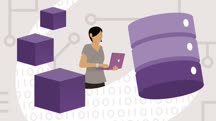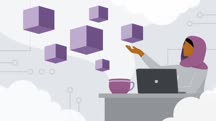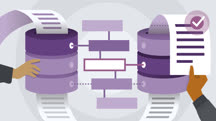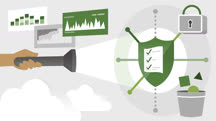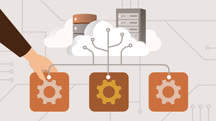Course catalog
Categories
Showing 141-160 of 1,450 items.
AWS Certified Database – Specialty (DBS-C01): 1 Introduction and Services (221473)
Earning the AWS Certified Database – Specialty certification validates your understanding of AWS database services and ability to design and maintain database solutions. In this course—the first in a series designed to help you prepare for the AWS Certified Database – Specialty (DBS-C01) exam—review fundamental database concepts and the different database services offered by AWS. Instructor Tom Carpenter begins by going over the exam objectives. He then provides an overview of key database concepts, including the differences between cloud-based and local databases and how to read and write data with SQL. Plus, learn about the different AWS database services, from relational databases like Aurora to in-memory databases like ElastiCache.
This Total Seminars course covers the exam certification topics. For information on additional study resources—including practice tests, lab simulations, books, and discounted exam vouchers—visit totalsem.com/linkedin. LinkedIn Learning members receive special pricing.
This course was created by Total Seminars. We are pleased to offer this training in our library.
This Total Seminars course covers the exam certification topics. For information on additional study resources—including practice tests, lab simulations, books, and discounted exam vouchers—visit totalsem.com/linkedin. LinkedIn Learning members receive special pricing.
This course was created by Total Seminars. We are pleased to offer this training in our library.
AWS Certified Database – Specialty (DBS-C01): 2 Design and Deployment (221456)
All quality databases begin with a thoughtful design. In this installment of the AWS Certified Database – Specialty (DBS-C01) series, learn how to design and deploy AWS database solutions as you study for exam DBS-C01. Instructor Tom Carpenter covers database design tools and explains how to design a database for performance, scalability, and compliance. Tom then goes over the backup processes and options related to Amazon Relational Database Service (Amazon RDS) and instance-based database solutions in AWS, as well as the high-availability options in AWS. Plus, he steps through the process of creating RDS, DynamoDB, Redshift, and instance-based databases.
This Total Seminars course covers the exam certification topics. For information on additional study resources—including practice tests, lab simulations, books, and discounted exam vouchers—visit totalsem.com/linkedin. LinkedIn Learning members receive special pricing.
This course was created by Total Seminars. We are pleased to offer this training in our library.
This Total Seminars course covers the exam certification topics. For information on additional study resources—including practice tests, lab simulations, books, and discounted exam vouchers—visit totalsem.com/linkedin. LinkedIn Learning members receive special pricing.
This course was created by Total Seminars. We are pleased to offer this training in our library.
AWS Certified Database – Specialty (DBS-C01): 3 Migration and Management (228834)
Validate your understanding of how to design and maintain AWS database solutions by earning the AWS Certified Database – Specialty certification. In this course—the third installment in a series—review database migration strategies and the basic processes used in database management as you prepare for exam DBS-C01. Instructor Tom Carpenter covers how to formulate an effective database migration strategy, prepare data for migration, and execute and validate a data migration. He then goes over key processes for managing databases, including how to extract, load, and archive data and perform both an unmanaged and managed database backup. To wrap up, he discusses how to manage database services, including how to work with DynamoDB and Redshift.
This Total Seminars course covers the exam certification topics. For information on additional study resources—including practice tests, lab simulations, books, and discounted exam vouchers—visit totalsem.com/linkedin. LinkedIn Learning members receive special pricing.
This course was created by Total Seminars. We are pleased to offer this training in our library.
This Total Seminars course covers the exam certification topics. For information on additional study resources—including practice tests, lab simulations, books, and discounted exam vouchers—visit totalsem.com/linkedin. LinkedIn Learning members receive special pricing.
This course was created by Total Seminars. We are pleased to offer this training in our library.
AWS Certified Database – Specialty (DBS-C01): 4 Monitoring and Troubleshooting (226828)
To pass the AWS Certified Database – Specialty (DBS-C01) exam—and succeed in a database-focused role—you need a solid understanding of how to monitor database operations and troubleshoot common problems. In this course, the final installment in the AWS Certified Database – Specialty (DBS-C01) series—instructor Tom Carpenter helps equip you with these key skills as he prepares you for exam DBS-C014. Learn how to work with CloudWatch, which can monitor and report on events logged by CloudTrail, as well as other events. Review auditing concepts and monitoring’s role in auditing. Get tips for enhancing the performance of your database. Plus, learn how to troubleshoot data access issues, availability problems, data corruption issues, and more.
This Total Seminars course covers the exam certification topics. For information on additional study resources—including practice tests, lab simulations, books, and discounted exam vouchers—visit totalsem.com/linkedin. LinkedIn Learning members receive special pricing.
This course was created by Total Seminars. We are pleased to offer this training in our library.
This Total Seminars course covers the exam certification topics. For information on additional study resources—including practice tests, lab simulations, books, and discounted exam vouchers—visit totalsem.com/linkedin. LinkedIn Learning members receive special pricing.
This course was created by Total Seminars. We are pleased to offer this training in our library.
AWS for Azure Administrators (233016)
The rise of multicloud scenarios has made multicloud skills a valuable commodity for enterprise IT pros. If you’re an Azure admin, you can translate your existing skills to a new platform and exponentially increase your expertise and career prospects. In this course, instructor Sharon Bennett guides Azure admins through Amazon Web Services (AWS), showing how the techniques and tools you already know migrate to the platform. She offers a thorough explanation and comparison across infrastructure, management tools, security, storage, compute services, virtual networking, and databases. You can learn how AWS helps administrators manage costs, authorization and access, data transfer, and much more—all without wasting valuable time on the concepts you already understand.
AWS for Developers: Amazon Corretto and Java (231503)
Do you want to explore the features of Amazon Corretto, the production-grade, open-source Java environment from Amazon? In this course, instructor Carlos Rivas walks you through everything from setup to integration. Carlos shows you how to install Amazon Corretto on both Windows and Linux and goes over how to change runtime settings when needed. He explains how to measure the performance of Amazon Corretto with some sample code, then covers how to run the same performance-measuring code with OpenJDK for comparison. After demonstrating how to include Oracle Java in your performance test, Carlos describes how to compare test results to determine which Java implementation is best for your use cases. Next, he dives into how to set up containers, such as Docker Hub and Corretto Dockerfile, and how to run a deployment from your Dockerfile. Carlos finishes up by showing you how to integrate Corretto with Visual Studio code, IntelliJ IDEA, and Eclipse.
AWS for Developers: SNS, SQS, and SWF (229259)
Are you unclear about how to best work with the messaging, queueing, and workflow services offered by AWS? If so, this course can help. Join Jeremy Villeneuve as he shines a spotlight on three key AWS services—Simple Workflow Service (SWF), Simple Queue Service (SQS), and Simple Notification Service (SNS)—and how they can help you effectively handle complex workflows. Since each service was designed to address a specific methodology of the messaging/queueing/workflow model, Jeremy spells out the key differences in methodologies so you can ensure you're using the right tool for the right job. Along the way, get hands-on experience with SQS and SNS, and learn how to refactor an existing application that tracks user state within a database table to a workflow model provided by SWF.
AWS Security Hub First Look (228001)
AWS Security Hub—a security dashboard and insights tool from Amazon—provides users with a one-stop dashboard from which they can monitor their deployment for common security issues, including vulnerable services and publicly available S3 buckets. Security Hub provides a convenient and flexible search tool to filter issue types, and identifies fixes that need to be applied to resources. Amazon is currently allowing users to take this powerful tool out for a spin as a preview. In this course, Scott Simpson provides a first look at Security Hub, helping to acquaint you with the tool before it officially joins the AWS suite. Learn about the main features of Security Hub, as well as how it can help you gain new insights and resolve security problems.
AWS Well-Architected Framework: Cost Optimization Pillar (230619)
The AWS Well-Architected Framework helps architects build secure, high-performing, resilient, and efficient infrastructures for their applications through five pillars. This course takes an in-depth look at the cost optimization pillar. Instructor Mark Wilkins reviews how to use cost optimization with the design properties of the cost optimization pillar, then goes into key financial management concepts. He explores budgeting and forecasting tools for cloud costs. He shows you how to monitor cost, usage, and the decommissioning of resources, then offers information on how to choose a pricing model. Mark goes over how to manage costs using the Billing and Cost Management dashboard. He also discusses the challenge of changing your design as new features and abilities are provided over time, then shows you how to match supply and demand. Plus, he provides a demo in which he uses the Well-Architected Tool to answer cost optimization pillar questions.
AWS Well-Architected Framework: Performance Efficiency Pillar (228375)
The AWS Well-Architected Framework includes strategies to help enterprise architects compare workloads against AWS-identified best practices. It is designed to help architects build secure, high-performing, resilient, and efficient infrastructure for their applications and comprises five pillars: operational excellence, security, reliability, performance efficiency, and cost optimization. In this course, Mark Wilkins takes an in-depth look at the fifth pillar, performance efficiency. Mark covers the different computing resources—including compute, storage, database, and network—and shows how to optimize performance for each. He also illustrates the importance of fine-tuning performance to maintain efficiency over time. This course is designed to work in conjunction with the remaining courses in the path, and while Mark covers some topics that were detailed in the other pillars, in this course he looks at these topics specifically from the viewpoint of efficiency.
AWS Well-Architected Framework: Reliability Pillar (228494)
The AWS Well-Architected Framework was designed to help architects build secure, high-performing, resilient, and efficient infrastructure for their applications. The framework is comprised of five pillars: operational excellence, security, reliability, performance efficiency, and cost optimization. In this course, designed as part of a six-part series covering the AWS Well-Architected Framework, take a deeper look at the third pillar: reliability. Discover the purpose and place of the reliability pillar, plus key AWS reliability services such as CloudWatch. Learn about designing reliable infrastructure with Availability Zones, load balancing (ELB), and DNS (Route 53). Along the way, review demonstrations of real-world challenges and see how to implement key services to prevent—and recover from—failures.
AWS: Controlling Cost (234461)
Learn how to use Amazon Web Services (AWS) tools and best practices to understand, forecast, and control service costs. This course covers core AWS tools, such as CloudWatch billing alarms, consolidated billing with AWS Organizations, and the AWS billing dashboard tools. Instructor Lynn Langit shows how to control costs through key services, such as EC2, S3, RDS, and more. She also reviews architectural decisions related to cost control drawn from her own professional experiences.
AWS: Cost and Performance Optimization (230551)
As more and more organizations move their workloads and resources to the AWS cloud for its speed, elasticity, and flexible pricing options, it’s more important than ever to optimize processes to avoid extra costs and a heavy burden on resources. In this course, Shyam Raj provides guidance around controlling cloud costs and optimizing performance of apps in AWS. Shyam begins by discussing cost optimization strategies and best practices for improving resource performance. He then showcases AWS services designed to help monitor costs and those designed to help reduce cost by optimizing performance, covering AWS tools like AWS Budgets, Trusted Advisor, and Compute Optimizer. This course also covers the knowledge needed for anyone who is preparing for the corresponding domain of the AWS SysOps Administrator certification exam (SOA-C02).
AWS: Monitoring, Logging, and Remediation (232727)
As organizations increasingly move their workloads to the AWS cloud to take advantage of its speed, elasticity, and flexible pricing, it is more important than ever to continuously monitor your applications and workloads, and react to changes, to maintain a fault-tolerant and highly available ecosystem. In this course, Shyam Raj provides system administrators with a look at how to successfully monitor resources and applications and how to remediate problems that may arise. Shyam includes heavy coverage of AWS monitoring services, including CloudWatch, CloudTrail, and AWS Config. He explains how to navigate the dashboards of these services to view metrics, monitor performance, and configure resource limits. This course can also be used to prep for the corresponding domain of the AWS Certified SysOps Admin exam.
AWS: Networking (232744)
Adopting a cloud infrastructure strategy includes configuring a network that meets the needs of your organization. Amazon Web Services (AWS) is a cost-reducing solution that provides tools so you can build a data center with secure cloud networking technology. This course offers advice for technical managers and step-by-step instructions for system administrators and full-stack engineers. Learn how to establish private connections, set up a virtual private cloud, implement and configure Transit Gateway, create security groups, work with access control lists, and more. Plus, get troubleshooting tips and learn how to leverage AWS services such as CloudFront to securely deliver content to customers globally with low latency. Join IT architect Sharif Nijim as he takes you through foundational networking concepts and beyond so you can gain a broader and deeper sense of effective strategies and tools you can use.
Azure Administration: Deploy and Manage Compute Resources (220521)
Effectively managing compute resources is key to infrastructure administration—and a successful career in IT. In this course, instructor Sharon Bennett discusses how to successfully deploy and manage Microsoft Azure compute resources, focusing heavily on configuration of virtual machines. Sharon shows how to configure VMs for high availability and scalability, set up encryption, provision VMs, and automate VM deployment and configuration with Azure templates. She also teaches how to create and configure containers and web apps. This course is also a valuable resource for anyone preparing for the corresponding domain of the AZ-104 Azure Administrator certification exam. Level up your Azure skills today with these hands-on demos and practical techniques.
Azure for Architects: Design a Compute Strategy (228800)
Learn about designing a compute strategy with Microsoft Azure and prepare for the compute portion of the Exam AZ-301: Microsoft Azure Architect Design. Instructor Scott Duffy starts with an overview of Azure compute basics, then discusses pricing and shares best practices for managing costs in Azure. Scott covers migrating to serverless and microservices. He demonstrates how to use the command line, PowerShell, the Azure portal, and more.
Azure for Developers: Authenticating to Azure Services Using the Microsoft Identity Platform (233679)
In this course, instructor Sidney Andrews walks users through how to use tokens with Azure Services, how to register common Azure service APIs in Azure Active Directory, and how to connect securely to Azure Storage and Azure SQL Database. Learn how to search the catalog of APIs available in the Azure AD portal experience and how to configure API permissions for the Microsoft Graph. Find out how to configure the API permissions of various Azure services and how to read and understand examples of scopes for APIs. Explore the difference between application and delegated permissions for an API. Discover how to grant administrator consent. Follow the different steps to connect to an Azure SQL database or to Azure storage using Microsoft Authentication Library (MSAL) tokens. In conclusion, learn about connecting to Azure Cognitive Services using MSAL tokens.
Azure for Developers: Optimize with Azure Application Gateway (209794)
Architecting your applications with Azure Application Gateway helps you to improve your application scalability, costs, and security. In this course, instructor Karl Ots covers what Azure Application Gateway is, how to use it to optimize workloads, and how to architect scalable and secure cloud applications. Karl discusses which service to choose in load balancing. He also explores load balancing in existing applications and cloud-native applications. Learn about the components of an Azure Application Gateway implementation. Find out about the design considerations and implementation details of Application Gateway HTTP(S) listeners, Application Gateway load balancing rules, and Application Gateway health probes. Karl demonstrates Application Gateway scaling capabilities and teaches how to work with encrypted traffic. Plus, he goes into advanced topics such as multi-site hosting, path-based routing, Web Application Firewall, building globally available web applications, and automation for DevOps.
Azure Logic Apps (230228)
Logic Apps simplify app integration, data integration, system integration, enterprise application integration (EAI), and business-to-business (B2B) communication, whether in the cloud, on premises, or both. In this course, instructor Vishwas Lele introduces you to Azure Logic Apps, shows you how to take apps from design to deployment, explains the Azure Event Grid, and offers some useful tips and tricks. Vishwas begins by explaining the role of Azure Logic Apps and how the serverless architecture of Logic Apps helps in better scaling and cut costs. He walks you through each step in designing, developing, building, and deploying your own logic apps. Vishwas goes over concepts for event-based logic apps as well as integration accounts. He concludes with useful tips and tricks on topics including connection limits, workflows, and many more.


